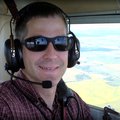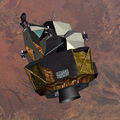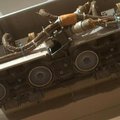 Hello every, welcome to Hack Chat! Today we've got not one but four hosts - CuriousMarc, Ken Shirriff, Mike Stewart, and Carl Claunch. They've done a lot of cool retro hacks, chief among them getting a real Apollo Guidance Computer working again for the first time in 50 years. Welcome all!
Hello every, welcome to Hack Chat! Today we've got not one but four hosts - CuriousMarc, Ken Shirriff, Mike Stewart, and Carl Claunch. They've done a lot of cool retro hacks, chief among them getting a real Apollo Guidance Computer working again for the first time in 50 years. Welcome all!
 Maybe you can each tell us a little about yourself to kick things off
Maybe you can each tell us a little about yourself to kick things off
![]() I am retired and able to devote all my time to restoring old mainframes and other vintage technology
I am retired and able to devote all my time to restoring old mainframes and other vintage technology
![]() I'm retired and looking for new projects.
I'm retired and looking for new projects.
 @carlclaunch51 - From what I understand, mainframe skills are a growth industry right now. At least for the short term ;-)
@carlclaunch51 - From what I understand, mainframe skills are a growth industry right now. At least for the short term ;-)
 I currently write flight software for satellites Capella Space, and devote pretty much all of my free time to Apollo digital archaeology in various forms
I currently write flight software for satellites Capella Space, and devote pretty much all of my free time to Apollo digital archaeology in various forms
 Hi. I'm a retired programmer and I've been researching vintage computing, reverse-engineering old microprocessors, mining Bitcoin by hand, and studying old aerospace computers.
Hi. I'm a retired programmer and I've been researching vintage computing, reverse-engineering old microprocessors, mining Bitcoin by hand, and studying old aerospace computers.
 Hello CuriousMarc here. In real life work on fiber optics at Samtec. Former Intel Fellow. In fantasy life restore old electronics with Carl and Ken and Mike in my over-equipped basement lab.
Hello CuriousMarc here. In real life work on fiber optics at Samtec. Former Intel Fellow. In fantasy life restore old electronics with Carl and Ken and Mike in my over-equipped basement lab.
![]() @Dan Maloney I ajm focused on the hardware side now, while the current short term interest is in software
@Dan Maloney I ajm focused on the hardware side now, while the current short term interest is in software
 Marc, Carl, and I have been working together at the Computer History Museum for a while, helping to keep the old IBM 1401 punch-card mainframe running. We also restored a Xerox Alto in Marc's basement. We joined up with Mike to restore the Apollo Guidance Computer.
Marc, Carl, and I have been working together at the Computer History Museum for a while, helping to keep the old IBM 1401 punch-card mainframe running. We also restored a Xerox Alto in Marc's basement. We joined up with Mike to restore the Apollo Guidance Computer.
 Actually that's how we all met (save for Mike), working at the Computer History Museum in Mountain View, CA
Actually that's how we all met (save for Mike), working at the Computer History Museum in Mountain View, CA
![]() We are all volunteers helping with restoration and digital archeology projects
We are all volunteers helping with restoration and digital archeology projects
 Stop by the museum (one quarantine is lifted) to see a punch-card machine running.
Stop by the museum (one quarantine is lifted) to see a punch-card machine running.
 That's still a bucket list trip for me. We had Dag Spicer on last year to talk about CHM and preserving our history. CHM is such a valuable resource.
That's still a bucket list trip for me. We had Dag Spicer on last year to talk about CHM and preserving our history. CHM is such a valuable resource.
 And Ken and I were introduced through a mutual friend, because I was about to try to restore an AGC, but didn't yet have any experience working with old hardware at all
And Ken and I were introduced through a mutual friend, because I was about to try to restore an AGC, but didn't yet have any experience working with old hardware at all
 yeah for sure
yeah for sure
 And if you have an old 1960's mainframe in your basement please let us know
And if you have an old 1960's mainframe in your basement please let us know
![]() How about my garage?
How about my garage?
 I enjoyed watching your Apollo restoration videos and Soyuz clock.
I enjoyed watching your Apollo restoration videos and Soyuz clock.
 I've always been a bit envious of the CHM and the people around it, here in the Netherlands there is no such pool of retro repair knowledge and resources
I've always been a bit envious of the CHM and the people around it, here in the Netherlands there is no such pool of retro repair knowledge and resources
 It's amazing how much technology progressed from the IBM 1401 at the museum (1959) to the Apollo Guidance Computer (mid-1960s). The 1401 uses transistors (germanium, not silicon) while the Apollo Guidance Computer uses integrated circuits. They both use magnetic core memory for storage, though.
It's amazing how much technology progressed from the IBM 1401 at the museum (1959) to the Apollo Guidance Computer (mid-1960s). The 1401 uses transistors (germanium, not silicon) while the Apollo Guidance Computer uses integrated circuits. They both use magnetic core memory for storage, though.
 @carlclaunch51 Yes you have quite a few but you won't let me film ;-)
@carlclaunch51 Yes you have quite a few but you won't let me film ;-)
![]() From https://blog.samtec.com/post/restoring-agc-part1/ "When powered, the system came to 4.99 +/- 0.01 volts. Think about that: this is 50 plus year old equipment which had been in storage for decades, and it was running within 0.20% of the original specification! "
From https://blog.samtec.com/post/restoring-agc-part1/ "When powered, the system came to 4.99 +/- 0.01 volts. Think about that: this is 50 plus year old equipment which had been in storage for decades, and it was running within 0.20% of the original specification! "
![]() That is a m a z i n g !
That is a m a z i n g !
 @curiousmarc , if I had a teletype in my garage I'd want to restore it. That last video gave me a nostalgia attack
@curiousmarc , if I had a teletype in my garage I'd want to restore it. That last video gave me a nostalgia attack
![]() @curiousmarc yes I have been a bit obstructionist towards filming until my garage looks better.
@curiousmarc yes I have been a bit obstructionist towards filming until my garage looks better.
![]() Can you recommend any books for people who can't get enough Apollo-era technology?
Can you recommend any books for people who can't get enough Apollo-era technology?
 Sunburst and Luminary by Don Eyles is fantastic
Sunburst and Luminary by Don Eyles is fantastic
![]() Rocket Ranch and related books are excellent for a KSC oriented view
Rocket Ranch and related books are excellent for a KSC oriented view
 +1 on Don Eyles book
+1 on Don Eyles book
 when the series first started i was wondering whether a modern replica of the AGC would be possible, but I couldn't find gates with a similar open collector output and logic function (not in the 74 series at least). are there any chips still in production that could be used one-for-one without significantly altering the design?
when the series first started i was wondering whether a modern replica of the AGC would be possible, but I couldn't find gates with a similar open collector output and logic function (not in the 74 series at least). are there any chips still in production that could be used one-for-one without significantly altering the design?
 especially the bit where they form logic by tying outputs of gates together
especially the bit where they form logic by tying outputs of gates together
 Eldon Hall's Journey to the Moon: The History of the Apollo Guidance Computer is another good book.
Eldon Hall's Journey to the Moon: The History of the Apollo Guidance Computer is another good book.
 I have a plan for that for my replica -- one sec
I have a plan for that for my replica -- one sec
 Open collector gates? You can still get them in the 74xx series
Open collector gates? You can still get them in the 74xx series
![]() Digital Apollo by David A. Mindell
Digital Apollo by David A. Mindell
 not in the dual three-input NOR variety though
not in the dual three-input NOR variety though
 But the tough bit is the memory tray B
But the tough bit is the memory tray B
![]() not sure about triple input NOR with open collectors
not sure about triple input NOR with open collectors
 been a while since i looked at it but yep think the 3 input NOR was the problem
been a while since i looked at it but yep think the 3 input NOR was the problem
 Just a note, I'll be pulling a transcript at the end and posting it publically, so don't worry about capturing links or titles of books - it'll all be there for you later.
Just a note, I'll be pulling a transcript at the end and posting it publically, so don't worry about capturing links or titles of books - it'll all be there for you later.
 Dang we have to make a new wafer of it
Dang we have to make a new wafer of it
![]() new project!
new project!

https://www.digikey.com/product-detail/en/texas-instruments/SN74LVC06APWR/296-8437-2-ND/377383
 i though about spinning small pcbs with real tiny SMD transistors
i though about spinning small pcbs with real tiny SMD transistors
 Peter: you could probably use surface-mount transistors and emulate the integrated circuits directly without increasing the size much. The integrated circuits in the AGC were just 2 transistors + 6 resistors.
Peter: you could probably use surface-mount transistors and emulate the integrated circuits directly without increasing the size much. The integrated circuits in the AGC were just 2 transistors + 6 resistors.
 those were my plan -- a hex open-drain inverter behaves much like a dual open-drain three-input nor gate with outputs tied together in triples
those were my plan -- a hex open-drain inverter behaves much like a dual open-drain three-input nor gate with outputs tied together in triples
 Sorry, 8 resistors in the AGC's IC.
Sorry, 8 resistors in the AGC's IC.
 thats a good one :) couldn't get the layout small enough for a size accurate PCB module, but might just not have found small enough packages
thats a good one :) couldn't get the layout small enough for a size accurate PCB module, but might just not have found small enough packages
![]() being core memory, was the program still intact when you got the AGC running?
being core memory, was the program still intact when you got the AGC running?
 What are you going to do for memory Mike? Wanna use that big IBM FAA core memory I have at home?
What are you going to do for memory Mike? Wanna use that big IBM FAA core memory I have at home?
 Yes, Mike was able to read the memory from the AGC.
Yes, Mike was able to read the memory from the AGC.
![]() quad input 4002b? push-pull output
quad input 4002b? push-pull output
![]() Any idea of what mission it was planned for?
Any idea of what mission it was planned for?
 my plan was always to attempt to weave my own, with those cores I bought, but it's unclear how far into that I would get before giving up
my plan was always to attempt to weave my own, with those cores I bought, but it's unclear how far into that I would get before giving up
![]() @brianpagephotog we had a dead bit but due to having parity it was possible to rewire and extract the data. One of Marc's videos details the effort
@brianpagephotog we had a dead bit but due to having parity it was possible to rewire and extract the data. One of Marc's videos details the effort
 We could tell exactly what the AGC was running and displaying when it was shut off. It was doing an IMU alignment, with coordinates matching the Houston space center. It's in one of Marc's videos.
We could tell exactly what the AGC was running and displaying when it was shut off. It was doing an IMU alignment, with coordinates matching the Houston space center. It's in one of Marc's videos.
![]() Nice. I haven't seen the videos. Do you have a quick link?
Nice. I haven't seen the videos. Do you have a quick link?
 our AGC was never intended for a mission -- it was a prototype model, but it was installed in the LTA-8 lunar test article, and underwent the full LM thermal vacuum testing in Houston
our AGC was never intended for a mission -- it was a prototype model, but it was installed in the LTA-8 lunar test article, and underwent the full LM thermal vacuum testing in Houston
 @Mike Stewart That would be awesome. You might just be able to get some woven ones off 1970's boards like DEC.
@Mike Stewart That would be awesome. You might just be able to get some woven ones off 1970's boards like DEC.
 have you guys ever thought about wiring up more parts to it? like sensors or a radiomodem?
have you guys ever thought about wiring up more parts to it? like sensors or a radiomodem?

https://www.youtube.com/watch?v=2KSahAoOLdU&list=PL-_93BVApb59FWrLZfdlisi_x7-Ut_-w7
![]() Thanks!
Thanks!
![]() The AGC video series was fantastic -- it made for great viewing, and showcased each of your unique talents beautifully.
The AGC video series was fantastic -- it made for great viewing, and showcased each of your unique talents beautifully.
 That's 31 videos, though - not sure which one Ken was talking about. They're all worth watching, of course ;-)
That's 31 videos, though - not sure which one Ken was talking about. They're all worth watching, of course ;-)
 Peter: the AGC is back in Houston now, so we don't have an opportunity to wire up more things to it.
Peter: the AGC is back in Houston now, so we don't have an opportunity to wire up more things to it.

https://archive.org/download/S68-21511/S68-21511.jpg
![]() @Peter Bosch we did hook up some inputs and outputs including simulating various IMU inputs, but we don't have access to the AGC which stopped any future experiments
@Peter Bosch we did hook up some inputs and outputs including simulating various IMU inputs, but we don't have access to the AGC which stopped any future experiments
 ^^ there's a picture of our AGC installed in the Lunar Module, taken in the thermal vacuum chamber in 1968
^^ there's a picture of our AGC installed in the Lunar Module, taken in the thermal vacuum chamber in 1968
![]() and Ken got a picture of LTA 8 hanging in Johnson Space Center with a gaping hole where the AGC belonged, shot through the open hatch
and Ken got a picture of LTA 8 hanging in Johnson Space Center with a gaping hole where the AGC belonged, shot through the open hatch
 Dan I'm not sure which video shows the original contents. Probably around number 13. Maybe Marc remembers.
Dan I'm not sure which video shows the original contents. Probably around number 13. Maybe Marc remembers.
 @Peter Bosch I miss that machine so much. It's back with its owner. But between all of us we'd have a lot to attach to it: the radio telemetry, Carl is working on a real DSKY display, I have a gyro, Mike has the ground control box for uploads...
@Peter Bosch I miss that machine so much. It's back with its owner. But between all of us we'd have a lot to attach to it: the radio telemetry, Carl is working on a real DSKY display, I have a gyro, Mike has the ground control box for uploads...
 Wow, besides your gyro video, any other videos in the making on those?
Wow, besides your gyro video, any other videos in the making on those?
![]() I also built a telemetry interface so that I could stream out the data that would have been downlinked to mission control
I also built a telemetry interface so that I could stream out the data that would have been downlinked to mission control
 Give me a moment I'll try to dig the video out.
Give me a moment I'll try to dig the video out.
 we can still take trips out to work with it, for what it's worth -- I've flown out with more rope modules from Don Eyles to dump their contents using it. it's just that flying back and forth to Houston to work with it is a bit prohibitive
we can still take trips out to work with it, for what it's worth -- I've flown out with more rope modules from Don Eyles to dump their contents using it. it's just that flying back and forth to Houston to work with it is a bit prohibitive
![]() Plus a frivilous Lego LM model with tiny LEDs that were lit by the AGC as it commanded movement of the spacecraft, while we were running mission simulations
Plus a frivilous Lego LM model with tiny LEDs that were lit by the AGC as it commanded movement of the spacecraft, while we were running mission simulations
 This is a very strange question, but do we know exactly how the telemetry/data from the AGC went into the RTCC and then into mission control on their high resolution monitors? Everything I've researched about RTOS comes up blank.
This is a very strange question, but do we know exactly how the telemetry/data from the AGC went into the RTCC and then into mission control on their high resolution monitors? Everything I've researched about RTOS comes up blank.
 Thank you guys for putting your energy and talent into all of this restoration work, especially the AGC. It's incredibly inspiring and fun to follow the project. So much to be [re-]learned!
Thank you guys for putting your energy and talent into all of this restoration work, especially the AGC. It's incredibly inspiring and fun to follow the project. So much to be [re-]learned!
 Lego + AGC for the win! :-) Two great things I never imagined would be together.
Lego + AGC for the win! :-) Two great things I never imagined would be together.
 @cprossu the expert on the RTCC is a guy by the name of Niklas Beug, who is currently the primary maintainer for NASSP -- if you have IRC, we have a freenode channel #nassp, and I'm sure he would be happy to talk about it
@cprossu the expert on the RTCC is a guy by the name of Niklas Beug, who is currently the primary maintainer for NASSP -- if you have IRC, we have a freenode channel #nassp, and I'm sure he would be happy to talk about it
 Who happens to be here
Who happens to be here
![]() We know exactly what data was downlinked, but there doesn't seem to be anything on the RTOS on the 360/75 computers. Probably the screen layouts in mission control are known
We know exactly what data was downlinked, but there doesn't seem to be anything on the RTOS on the 360/75 computers. Probably the screen layouts in mission control are known
 oh hello
oh hello
 lol
lol
![]() Hi Niklas
Hi Niklas
 hey Niklas!
hey Niklas!
 This video: . That's the first thing we did when we got it fully running for the first time before rewiring the memory.
This video: . That's the first thing we did when we got it fully running for the first time before rewiring the memory.
 That is awesome @Mike Stewart
That is awesome @Mike Stewart
 Hey guys. But I don't really know much about telemetry. It was downlinked from the AGC through tracking stations, processed in the RTCC computers and then available for display.
Hey guys. But I don't really know much about telemetry. It was downlinked from the AGC through tracking stations, processed in the RTCC computers and then available for display.
![]() Marc built a bit of hardware to produce the pulses that would have flooded the AGC with spurious movement data from the resolver for the LM rendezvous radar on Apollo 11.
Marc built a bit of hardware to produce the pulses that would have flooded the AGC with spurious movement data from the resolver for the LM rendezvous radar on Apollo 11.
 What amazes me is I found an old philco ford document that has all the numbers and descriptions of how mission control was built @carlclaunch51 . No pictures though
What amazes me is I found an old philco ford document that has all the numbers and descriptions of how mission control was built @carlclaunch51 . No pictures though
![]() and you got the 1201/1202 alarms?
and you got the 1201/1202 alarms?
 As far as the mission control displays, it wasn't easy to project images onto a big screen. They used an early projection technology called Eidophor. It used electrostatic charges to deform an oil surface(!) A scanning electron beam "drew" on the surface and they reflected light off the oil. https://en.wikipedia.org/wiki/Eidophor
As far as the mission control displays, it wasn't easy to project images onto a big screen. They used an early projection technology called Eidophor. It used electrostatic charges to deform an oil surface(!) A scanning electron beam "drew" on the surface and they reflected light off the oil. https://en.wikipedia.org/wiki/Eidophor
 That's why it would be really cool to get the telemetry stream out of the real thing with Carl's contraption.
That's why it would be really cool to get the telemetry stream out of the real thing with Carl's contraption.
 This Ars article from a while ago has a lot of information on the tech in the MCC - https://arstechnica.com/science/2012/10/going-boldly-what-it-was-like-to-be-an-apollo-flight-controller/2/
This Ars article from a while ago has a lot of information on the tech in the MCC - https://arstechnica.com/science/2012/10/going-boldly-what-it-was-like-to-be-an-apollo-flight-controller/2/
![]() We are all a bit obsessed with getting to the exact conditions and hardware behavior that led to the 1201/1202 errors
We are all a bit obsessed with getting to the exact conditions and hardware behavior that led to the 1201/1202 errors
 yeah, one of the main things I'm working on right now is understanding/simulating *exactly* what happened with those alarms. so far I haven't managed to replicate the described behavior exactly
yeah, one of the main things I'm working on right now is understanding/simulating *exactly* what happened with those alarms. so far I haven't managed to replicate the described behavior exactly
 Marc's pulse generator overloads the computer too much -- we get 1201s and 1202s, but far too many of them
Marc's pulse generator overloads the computer too much -- we get 1201s and 1202s, but far too many of them
![]() it is more complicated that it seems. Not just a stready stream of pulses at maximum rate.
it is more complicated that it seems. Not just a stready stream of pulses at maximum rate.
 how long did it take the original team to figure it out?
how long did it take the original team to figure it out?
 And just like that managed to find this one.
And just like that managed to find this one.

https://cdn2.hubspot.net/hubfs/413105/Apollo%20Press%20Kits/Philco%20Ford.pdf
 ^ Still though we need to find out more info on the system 360/75 rtos
^ Still though we need to find out more info on the system 360/75 rtos
![]() Wasn't it something to do with two AC power supplies that could be in different phases?
Wasn't it something to do with two AC power supplies that could be in different phases?

 Dan Maloney
Dan Maloney
Discussions
Become a Hackaday.io Member
Create an account to leave a comment. Already have an account? Log In.